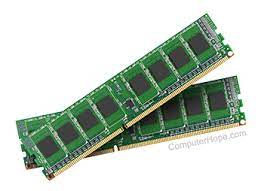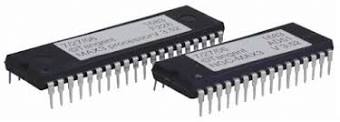PRIMARY OR INTERNAL MEMORY
Internal memory is also known as Main memory, primary memory. It is known as immediate Access Storage (I.A.S.) also, as this is the portion of computer’s central processing unit where current data and/or program remain resident for execution in computer. Primary storage is used for different purposes i.e
- Data are fed into an input storage area where they are held until ready to be processed.
- A working storage space that’s like a sheet of scratch paper is used to hold the data being processed and the intermediate results of such processing.
- An output storage area holds the finished results of the processing operations until they can be released.
- In addition to these data-related purposes, the primary storage section also contains a program storage area that holds the processing instructions.
There are main two primary memory used in personal computers i.e. RAM and ROM.
RAM (Random Access Memory):
The kind of memory used for holding programs and data being executed is called random access memory or RAM. It is a volatile or temporary memory in which data can be read and write so it is called Read and Write Memory. When you switch off the computer all the data and programme are lost from the RAM. RAM needs to be writeable in order for it to do its job of holding programs and data that you are working on. The volatility of RAM also means that you risk losing what you are working on unless you save it frequently. It is much faster than other memory.

RAM is of two types:
- Static RAM (SRAM)
- Dynamic RAM (DRAM)
Static RAM (SRAM)
The word static indicates that the memory retains its contents as long as power remains applied. However, data is lost when the power gets down due to volatile nature. SRAM chips use a matrix of 6-transistors and no capacitors. Transistors do not require power to prevent leakage, so SRAM need not have to be refreshed on a regular basis.
Because of the extra space in the matrix, SRAM uses more chips than DRAM for the same amount of storage space, thus making the manufacturing costs higher.
Static RAM is used as cache memory needs to be very fast and small.
Characteristics of the Static RAM:
- It has long data lifetime
- There is no need to refresh
- Faster
- Large size
- Expensive
- High power consumption
Dynamic RAM (DRAM)
DRAM, unlike SRAM, must be continually refreshed in order for it to maintain the data. This is done by placing the memory on a refresh circuit that rewrites the data several hundred times per second. DRAM is used for most system memory because it is cheap and small. All DRAMs are made up of memory cells. These cells are composed of one capacitor and one transistor.
Characteristics of the Dynamic RAM:
- >It has short data lifetime
- Need to refresh continuously
- Used as RAM
- Lesser in size
- Less expensive
- Less power consumption
ROM (Read Only Memory)
It is another type of primary memory. The information is ‘burnt’ into the ROM chip at the manufacturing time. It cannot be altered and fresh information cannot be ‘written’ into a ROM so it is called Read Only Memory. The programme stored in ROM are always there, whether the power is on or not. The most common example is the system BIOS program, which is stored in a ROM called the system BIOS ROM.

Following are the various types of ROM:
MROM (Masked ROM)
The very first ROMs were hard-wired devices that contained a pre-programmed set of data or instructions. These kinds of ROMs are known as masked ROMs. It is inexpensive ROM.
PROM (Programmable Read only Memory)
PROM is read-only memory that can be modified only once by a user. The user buys a blank PROM and enters the desired contents using a PROM programmer. Inside the PROM chip, there are small fuses, which are burnt open during programming. It can be programmed only once and is not erasable.
EPROM (Erasable and Programmable Read Only Memory)
The EPROM can be erased by exposing it to ultra-violet light for a duration of up to 40 minutes. Usually, an EPROM eraser achieves this function. During programming, an electrical charge is trapped in an insulated gate region. The charge is retained for more than ten years because the charge has no leakage path. For erasing this charge, ultra-violet light is passed through a quartz crystal window (lid). This exposure to ultra-violet light dissipates the charge. During normal use the quartz lid is sealed with a sticker.
EEPROM (Electrically Erasable and Programmable Read Only Memory)
The EEPROM is programmed and erased electrically. It can be erased and reprogrammed about ten thousand times. Both erasing and programming take about 4 to 10 ms (milli second). In EEPROM, any location can be selectively erased and programmed. EEPROMs can be erased one byte at a time, rather than erasing the entire chip. Hence, the process of re-programming is flexible but slow.